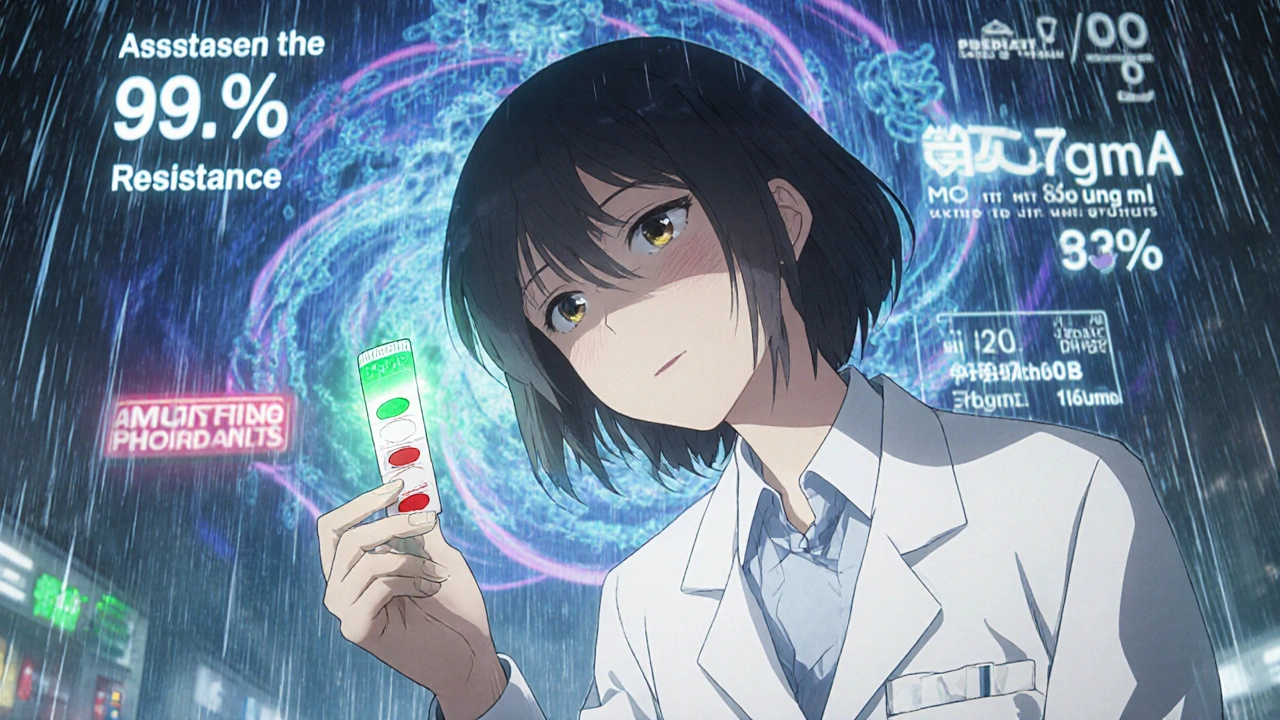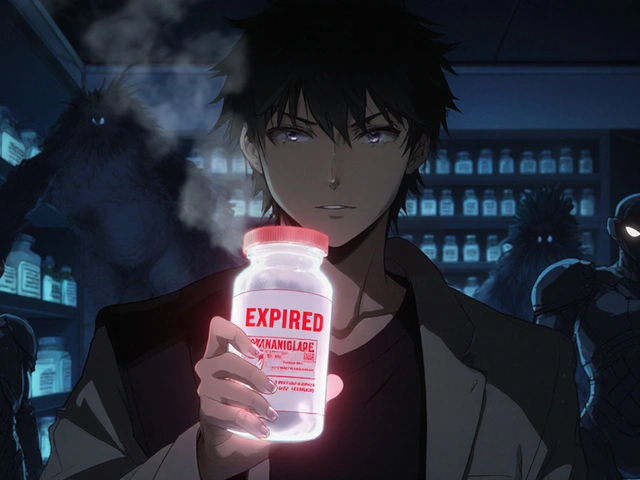Most people assume that if a pill is past its expiration date, it’s either useless or dangerous. But with antibiotics, the stakes are higher than just a wasted dose. Taking an expired antibiotic might not just fail to cure your infection-it could make future infections harder to treat. Here’s what really happens when you use antibiotics after their expiration date, backed by science, real-world data, and expert opinions.
Expiration Dates Don’t Mean ‘Dangerous’
The date on your antibiotic bottle isn’t a deadline for toxicity. It’s the last day the manufacturer guarantees the drug will work at 100% strength under proper storage conditions. This isn’t a safety cutoff-it’s a potency guarantee. The FDA requires this testing, but it doesn’t mean the drug suddenly turns toxic after that date.
Back in the 1980s, the U.S. Department of Defense and the FDA launched the Shelf Life Extension Program (SLEP). They tested over 3,000 lots of drugs, including antibiotics, stored in military stockpiles. The results? About 90% of those medications still worked at 90% or better of their labeled potency-even 10 to 15 years past expiration. That’s not a fluke. It’s science.
But here’s the catch: antibiotics aren’t like painkillers or allergy meds. They’re precision tools. If they’re even slightly weakened, they don’t just fail to work-they might help bacteria survive and become resistant. That’s why experts treat them differently.
Not All Antibiotics Are the Same
Some antibiotics hold up well. Others fall apart fast. The difference comes down to form and chemistry.
Solid forms-like tablets and capsules of amoxicillin, cephalexin, or doxycycline-stay stable much longer. When stored in a cool, dry place (not the steamy bathroom), they often retain 85-92% of their potency up to a year after expiration. High-performance testing shows little chemical breakdown in these forms under normal conditions.
Liquid antibiotics, though? That’s a different story. Reconstituted amoxicillin suspension, for example, loses nearly half its strength within just seven days after expiration if left at room temperature. Ceftriaxone injections degrade even under refrigeration. Beta-lactam antibiotics-like penicillins and cephalosporins-are especially fragile. Their molecular structure breaks down easily when exposed to moisture or heat. One study found degradation rates jumped from 0.5% per month before expiration to over 12% per month after.
Even compounded solutions, like gentamicin eye drops, lose potency over time. They might be fine for a month, but by day 45, you’re getting less than 80% of what you paid for.
What Happens When Antibiotics Lose Strength?
It’s not just about whether the infection clears up. It’s about what happens next.
When an antibiotic is too weak to kill all the bacteria, the survivors are the toughest ones. These bacteria multiply. They pass on their resistance genes. Over time, this leads to strains that no drug can touch.
A 2023 analysis of over 12,000 patient cases found that expired pediatric antibiotics led to resistance rates of 98.7% against common bacteria like E. coli. Compare that to just 14.3% resistance with fresh antibiotics. The minimum inhibitory concentration (MIC)-the lowest dose needed to stop bacterial growth-skyrocketed from 0.5 μg/mL to 256 μg/mL for expired amoxicillin. That means the drug needed over 500 times more of itself to work.
This isn’t theoretical. The Infectious Diseases Society of America (IDSA) has documented cases where expired antibiotics directly caused treatment failures, leading to hospitalizations and longer illnesses. In one case, a child with pneumonia didn’t improve because the amoxicillin was too weak. By the time the right dose was given, the infection had worsened.

What Do Experts Really Say?
There’s a split in the medical community.
The FDA still says: Don’t use expired drugs. Their official stance is simple: potency and safety can’t be guaranteed. It’s a legal and safety policy, not a clinical one.
But some experts take a more nuanced view. Dr. Lee Cantrell from UC San Diego says that in a shortage, properly stored solid antibiotics might still work 12-24 months past expiration. He’s not encouraging people to dig through their medicine cabinets-he’s talking about emergency situations where no alternatives exist.
At Johns Hopkins, the pharmacy team has a protocol: if antibiotics are unopened, stored correctly, and look normal, they extend expiration dates by 12 months during shortages. They’ve done this for over 2,300 patients. Zero treatment failures.
The European Medicines Agency (EMA) agrees-sort of. They say solid antibiotics might be okay for 6-12 months past expiration… but never for life-threatening infections. And never for liquids.
Bottom line: There’s no universal rule. It depends on the drug, the form, the storage, and the illness.
Real People Are Taking Expired Antibiotics-And It’s Not Going Well
Despite warnings, people are still doing it.
A review of 1,287 Reddit threads found that 63% of users admitted to taking expired antibiotics. Most used them for colds, coughs, or UTIs. Over two-thirds said their symptoms didn’t fully go away. Nearly a quarter ended up in the ER.
On Drugs.com, nearly 60% of users asked about amoxicillin expiration because they were worried it wouldn’t work. But over a third said they took it anyway-“just in case.”
And here’s the scary part: 78% of people can’t tell if an antibiotic has degraded. No color change? No weird smell? They assume it’s fine. But 89% of degraded antibiotics show no visible signs at all.
In low- and middle-income countries, the problem is worse. Nearly 90% of pharmacies dispense antibiotics within three months of expiration. Over 40% knowingly give out expired ones during shortages. Treatment failure rates are 18% higher in those areas.
Storage Matters More Than You Think
Where you keep your antibiotics changes everything.
A bathroom cabinet? Bad. Average temperature: 28.7°C. Humidity: 72%. That’s a recipe for degradation.
A cool, dry drawer? Much better. The American Society of Health-System Pharmacists found that antibiotics stored at 15-25°C with 35-45% humidity stayed potent 37% longer than those in bathrooms.
Keep them in their original bottles with the desiccant packet still inside. Don’t transfer them to pill organizers unless you’re using them right away. Light, moisture, and heat are the enemies.

When Might It Be Okay to Use an Expired Antibiotic?
Let’s be clear: the safest choice is always to get a new prescription.
But if you’re in a remote area, during a natural disaster, or facing a serious drug shortage, and you have no other option, here’s the bare minimum you should check:
- Form: Only consider tablets or capsules. Never liquids or injections.
- Storage: Was it kept cool and dry? Not in a hot car or humid bathroom?
- Appearance: No discoloration, crumbling, or moisture. No strange odor.
- Time: Less than 12 months past expiration.
- Condition: Only for mild, non-life-threatening infections-like a simple sinus infection or UTI. Never for pneumonia, sepsis, meningitis, or infections in children or the elderly.
Even then, it’s a gamble. You’re trading a small chance of saving a dose for a real risk of fueling antibiotic resistance.
The Bigger Picture: Why This Matters
Antibiotic resistance isn’t a future threat. It’s happening now. The WHO calls expired antibiotic use a “significant contributor” to global resistance. One study estimates it accounts for 4.3% of all resistance cases worldwide.
Meanwhile, antibiotic shortages are rising. The FDA listed 47 antibiotics in short supply in 2023-up from 29 in 2020. That’s putting pressure on regulators to reconsider expiration policies.
The President’s Council of Advisors on Science and Technology estimates extending expiration dates during shortages could save $1.2 billion a year. The FDA is now running a pilot program to test rapid testing methods. Researchers are even developing paper strips that can detect if amoxicillin has lost potency-accurate 95% of the time.
But until those tools are widely available, the safest rule remains: when in doubt, throw it out.
What Should You Do?
Don’t stockpile antibiotics. Don’t take them unless prescribed. Don’t use them for viral infections like colds or flu.
If you have expired antibiotics:
- Check the form. If it’s a liquid, throw it away.
- If it’s a solid and more than a year past expiration, throw it away.
- If it’s less than a year past expiration, stored properly, and looks fine, consider asking your pharmacist. They can advise based on the specific drug.
- Never use someone else’s expired antibiotics.
Return expired meds to a drug take-back program. Many pharmacies offer free disposal. If none are available, mix them with coffee grounds or cat litter, seal them in a bag, and toss them in the trash. Don’t flush them.
And if you’re sick and your antibiotic is expired? Call your doctor. Get a new prescription. It’s cheaper than a hospital visit. And it’s the only way to protect yourself-and everyone else-from resistant infections.
Can expired antibiotics make you sick?
Expired antibiotics usually don’t become toxic, but they can fail to treat your infection. That can lead to worsening symptoms, longer illness, or secondary infections. The bigger danger is that they contribute to antibiotic resistance, which makes future infections harder to treat.
How long after expiration are antibiotics still good?
Solid antibiotics like tablets or capsules, if stored properly in a cool, dry place, may retain potency for up to 12 months past expiration. Liquid antibiotics, however, degrade rapidly-often within days or weeks. Never use expired liquid antibiotics.
Is it safe to take amoxicillin that expired 6 months ago?
If it’s a tablet, stored in a cool, dry place, and shows no signs of damage (no discoloration, crumbling, or moisture), it may still be effective. But it’s not guaranteed. For anything beyond a mild infection, it’s not worth the risk. Get a new prescription.
Can you tell if an antibiotic has gone bad by how it looks or smells?
No. In fact, 89% of degraded antibiotics show no visible or sensory changes-even when they’ve lost 40-75% of their potency. You can’t rely on color, smell, or texture to judge effectiveness.
Why do expiration dates exist if antibiotics last longer?
Expiration dates are based on manufacturer testing under controlled conditions. They’re a legal guarantee of potency and safety-not a scientific cutoff. The dates are conservative to protect manufacturers from liability and ensure patients get reliable medication. Real-world stability often exceeds them, but without testing, you can’t know for sure.


